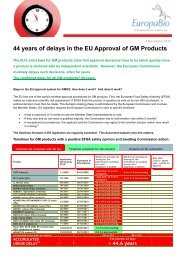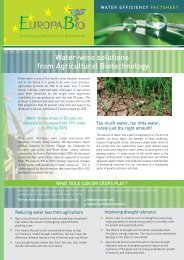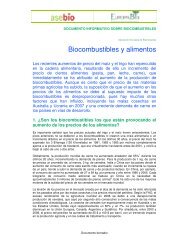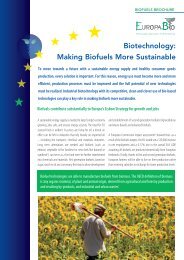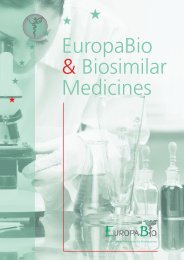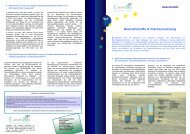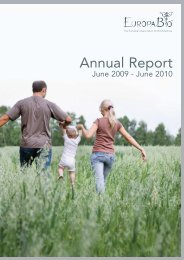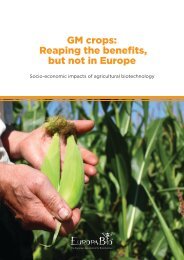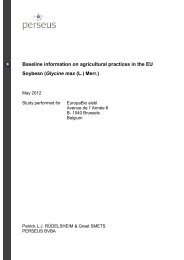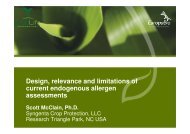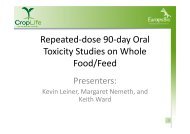Baseline information on agricultural practices in the EU ... - Europabio
Baseline information on agricultural practices in the EU ... - Europabio
Baseline information on agricultural practices in the EU ... - Europabio
Create successful ePaper yourself
Turn your PDF publications into a flip-book with our unique Google optimized e-Paper software.
Table 10: M<strong>in</strong>eral c<strong>on</strong>tent (<strong>in</strong> kg/ha/t<strong>on</strong>ne) <strong>in</strong> gra<strong>in</strong> maize (Source: Maiskomitee)<br />
Nutrient Gra<strong>in</strong> maize at 86% dry weight<br />
Gra<strong>in</strong> Straw<br />
N 12-16 5-9<br />
P2O5 6-11 5-7<br />
K2O 4-6 15-25<br />
MgO 2-3 2-4<br />
CaO 2-3 5-7<br />
Nitrogen is generally <strong>the</strong> most limit<strong>in</strong>g nutrient for maize and is <strong>the</strong> most frequent applied fertiliser,<br />
sometimes fracti<strong>on</strong>ated (before sow<strong>in</strong>g and later <strong>in</strong> <strong>the</strong> grow<strong>in</strong>g seas<strong>on</strong>).<br />
Phosphorous uptake may be problematic early <strong>in</strong> <strong>the</strong> seas<strong>on</strong> due to cold wea<strong>the</strong>r. Phosphorous is<br />
applied <strong>in</strong> <strong>the</strong> row to facilitate uptake. With farmyard manure to satisfy <strong>the</strong> nitrogen requirement soils<br />
often do not need a phosphorous fertilizer. Potassium is applied as a whole at soil cultivati<strong>on</strong>. Maize is<br />
not sensitive to micr<strong>on</strong>utrient deficiencies.<br />
Farmers usually base <strong>the</strong>ir calculati<strong>on</strong>s for <strong>the</strong> optimum fertilisati<strong>on</strong> <strong>on</strong> soil analyses from samples<br />
taken <strong>in</strong> w<strong>in</strong>ter and dur<strong>in</strong>g <strong>the</strong> crop seas<strong>on</strong>. Several <str<strong>on</strong>g><strong>in</strong>formati<strong>on</strong></str<strong>on</strong>g> services provide models and advice<br />
to calculate <strong>the</strong> right dose of fertilisers to apply <strong>in</strong> <strong>the</strong> field as this may differ from <strong>on</strong>e field to ano<strong>the</strong>r.<br />
Examples are: Kennisakker (<strong>the</strong> Ne<strong>the</strong>rlands); Bodemkundige Dienst van België (Belgium); Arvalis<br />
(France); and at <strong>the</strong> Landwirtschaftskammern 16 (Germany). UK farmers may use <strong>the</strong> PLANET 3<br />
software to generate recommendati<strong>on</strong>s and <strong>the</strong> ‘Tried & Tested nutrient management plan’ toge<strong>the</strong>r<br />
with <strong>the</strong> guidel<strong>in</strong>es issued by DEFRA 17 .<br />
Table 11 gives some examples of amounts of applied fertilisers as found <strong>in</strong> several publicati<strong>on</strong>s and<br />
<strong>on</strong> <strong>in</strong>ternet sites. These figures <strong>on</strong>ly give a rough idea at <strong>the</strong> best. Each <strong>in</strong>dividual field will require a<br />
tailor-made fertilisati<strong>on</strong> tak<strong>in</strong>g <strong>in</strong>to account several factors.<br />
Table 11: Maize soil preparati<strong>on</strong> <strong>in</strong> relati<strong>on</strong> to tillage (opti<strong>on</strong>s, complemented with relative importance<br />
% of cultivated maize area), examples for fertiliser (N: nitrogen, P: phosphorus, K:<br />
potassium) and soil applicati<strong>on</strong> of <strong>in</strong>secticides, possibly specified per regi<strong>on</strong> (E: east part of<br />
<strong>the</strong> country, N: north, NE: nor<strong>the</strong>ast, SW: southwest, W: west) (Sources: a average figures,<br />
from Agreste; b Endure; c F<strong>in</strong>ke et al., 1999; d ILVO; e Maïshandboek, figures for P2O5 will<br />
go down <strong>in</strong> <strong>the</strong> com<strong>in</strong>g years (55-85 for 2013); f Baden-Württemberg ‘Umweltgerechte<br />
Landbewirtschaftung‘; g h<br />
Baden-Württemberg ‚Silomais Sortenversuche‘; Bayern,<br />
Sortenversuch Silomais; i IRTA/AGPME for Catal<strong>on</strong>ia; j M<strong>in</strong>istry of Agriculture (MADR); k<br />
Recommended <strong>in</strong> Micskei et al., 2010; l Anpromis website; m EuropaBio member<br />
companies)<br />
Z<strong>on</strong>e Member State Use Tillage<br />
A<br />
North<br />
Denmark Not specified 10% no<br />
plough<strong>in</strong>g<br />
Fertiliser<br />
(kg/ha)<br />
150 N 0%<br />
Est<strong>on</strong>ia - - -<br />
F<strong>in</strong>land - - -<br />
Latvia - - -<br />
Insecticides<br />
(% applied of<br />
<strong>the</strong> cultivated<br />
area)<br />
16 E.g. Nordrhe<strong>in</strong>-Westfalen: http://www.nm<strong>in</strong>.de/nm<strong>in</strong>nrw/<br />
17 http://www.planet4farmers.co.uk/<br />
http://www.nutrientmanagement.org/<br />
http://archive.defra.gov.uk/envir<strong>on</strong>ment/quality/water/waterquality/diffuse/nitrate/help-for-farmers.htm<br />
Page 26 of 64



